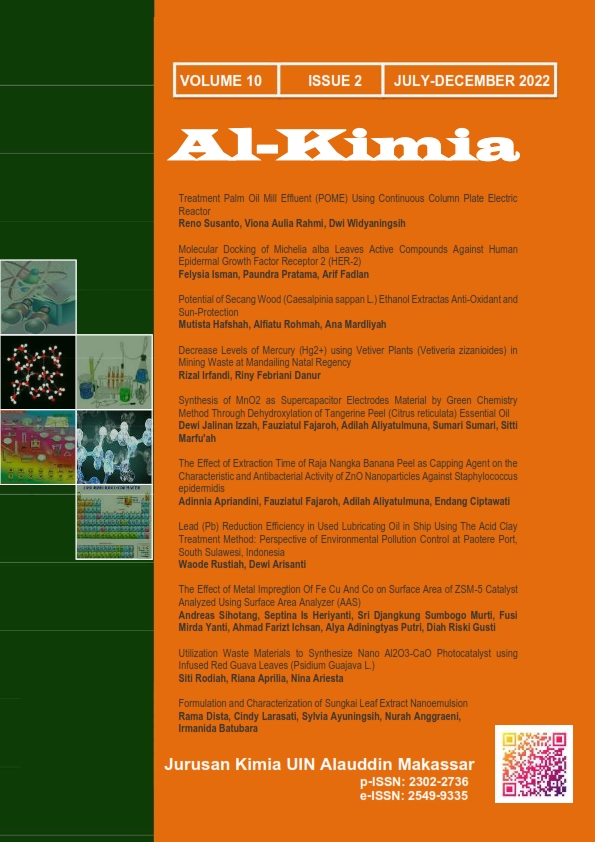Lead (Pb) Reduction Efficiency in Used Lubricating Oil in Ship Using The Acid Clay Treatment Method: Perspective of Environmental Pollution Control at Paotere Port, South Sulawesi, Indonesia
Abstract
The number of watercrafts in the sea will have an impact on the amount of waste lubricant oil that is discharged into the sea, which ultimately results in pollution. The increasing level of hazardous and toxic materials (B3 waste) is concerned to have a wider impact on public health and environment quality. One of the B3 wastes that requires special handling due to its high quantities is used lubricating oil. Utilization and processing of waste lubricant oil discharged from the ship is an alternative that can be applied to reach efficient consumption of petroleum which is shrinking from year to year. Therefore, we need a processing method that can reduce the pollutants generated from the waste, one of which is the Acid Clay Treatment method. This treatment aims to determine the best conditions for reducing heave metal lead (Pb) through Acid Clay Treatment method and to assess the decrease in Pb concentration contained in used lubricating oil from ship. The adsorbent used was clay that has been activated with sulphuric acid. The processing of used lubricating oil was carried out using three variations, including adsorbent concentration, contact time, and acidity (pH). The test results of used oil lubricating oil processing were 15 gram of adsorbent concentration, 90 minutes of contact time, and pH 4. The Pb reduction efficiency obtained from Acid Clay Treatment method in the best conditions was 53.72%.
Downloads
References
Abdelwahab Emam, E. (2018). Clay Adsorption Perspective on Petroleum Refining Industry. Industrial Engineering, 2(1), 19. https://doi.org/10.11648/j.ie.20180201.13
Ali, S. M. W., Ripin, A., & Ahmad, A. (2010). Adsorption of heavy metal from recovered base oil using zeolite. Journal of Applied Sciences, 10(21), 2688–2692. https://doi.org/10.3923/jas.2010.2688.2692
Botas, J. A., Moreno, J., Espada, J. J., Serrano, D. P., & Dufour, J. (2017). Recycling of used lubricating oil: Evaluation of environmental and energy performance by LCA. Resources, Conservation and Recycling, 125(January), 315–323. https://doi.org/10.1016/j.resconrec.2017.07.010
El-Mekkawi, S. A., El-Ibiari, N. N., Attia, N. K., El-Diwani, G. I., El-Ardy, O. A., & Morsi, A. K. E. (2020). Reducing the environmental impact of used lubricating oil through the production of fuels by pyrolysis. Environmental Nanotechnology, Monitoring and Management, 14, 100308. https://doi.org/10.1016/j.enmm.2020.100308
Fernández-Feal, M., Fernández-Feal, M., Sánchez-Fernández, L., & Pérez-Prado, J. (2018). Study of Metal Concentration in Lubricating Oil with Predictive Purposes. Current Journal of Applied Science and Technology, 27(6), 1–12. https://doi.org/10.9734/cjast/2018/41472
Halnor, S. (2015). Removal of Heavy Metals From Wastewater Effluents. Mmerals Engineering, 14(10), 1–4.
Homagai, P. L., Ghimire, K. N., & Inoue, K. (2011). Preparation and characterization of charred xanthated sugarcane bagasse for the separation of heavy metals from aqueous solutions. Separation Science and Technology, 46(2), 330–339. https://doi.org/10.1080/01496395.2010.506903
Jodeh, S., Odeh, R., Sawalha, M., Abu Obeid, A., Salghi, R., Hammouti, B., … Warad, I. (2015). Adsorption of lead and zinc from used lubricant oil using agricultural soil: Equilibrium, kinetic and thermodynamic studies. Journal of Materials and Environmental Science, 6(2), 580–591.
Kwasi Opoku, B., Ogbonna Friday, J., David Kofi, E., & Benson Osa, E. (2020). Adsorption of Heavy Metals Contaminants in Used Lubricating Oil Using Palm Kernel and Coconut Shells Activated Carbons. American Journal of Chemical Engineering, 8(1), 11. https://doi.org/10.11648/j.ajche.20200801.13
Mohammed, R. R., Ibrahim, I. A. R., Taha, A. H., & McKay, G. (2013). Waste lubricating oil treatment by extraction and adsorption. Chemical Engineering Journal, 220, 343–351. https://doi.org/10.1016/j.cej.2012.12.076
Oladimeji, T. E., Sonibare, J. A., Omoleye, J. A., Emetere, M. E., & Elehinafe, F. B. (2018). A review on treatment methods of used lubricating oil. International Journal of Civil Engineering and Technology, 9(12), 506–514.
Riyanto, Ramadhan, B., & Wiyanti, D. (2018). Treatment of Waste Lubricating Oil by Chemical and Adsorption Process Using Butanol and Kaolin. IOP Conference Series: Materials Science and Engineering, 349(1). https://doi.org/10.1088/1757-899X/349/1/012054
Rustiah, W. (2021). Determination of Zirconium(IV) Based on Flow Injection Analysis with The Xylenol Orange As A Complexing. Al-Kimia, 9(2), 141–150. https://doi.org/10.24252/al-kimia.v9i2.23638
Rustiah, W., Noor, A., Maming, Lukman, M., & Nurfadilah. (2020). Recent analysis of carbon, nitrogen, and lignin phenol compositions in the suspended particulate matters at spermonde archipelago, South Sulawesi, Indonesia. Environment and Natural Resources Journal, 18(2), 124–133. https://doi.org/10.32526/ennrj.18.2.2020.12
Sánchez-Alvarracín, C., Criollo-Bravo, J., Albuja-Arias, D., García-Ávila, F., & Raúl Pelaez-Samaniego, M. (2021). Characterization of used lubricant oil in a latin-american medium-size city and analysis of options for its regeneration. Recycling, 6(1), 1–22. https://doi.org/10.3390/recycling6010010
Waters, S., Sulawesi, S., Rustiah, W., Noor, A., & Lukman, M. (2019). ANALISIS DISTRIBUSI LOGAM BERAT TIMBAL DAN CADMIUM DALAM SEDIMEN SEPANJANG MUARA SUNGAI DAN LAUT PERAIRAN SPERMONDE , SULAWESI SELATAN , INDONESIA Distribution of Pb and Cd Heavy Metal Content in Sediments Along the River Estuary. 7(1), 1–8.
Zhu, Y., Zhu, Z., Zhao, X., Liang, Y., & Huang, Y. (2015). Characterization, dissolution, and solubility of lead hydroxypyromorphite [Pb5(PO4)3OH] at 25-45°C. Journal of Chemistry, 2015. https://doi.org/10.1155/2015/269387
Authors who publish with this journal agree to the following terms:
1) Authors retain copyright and grant the journal right of first publication with the work simultaneously licensed under a Creative Commons Attribution License that allows others to share the work with an acknowledgement of the work's authorship and initial publication in this journal.
2) Authors are able to enter into separate, additional contractual arrangements for the non-exclusive distribution of the journal's published version of the work (e.g., post it to an institutional repository or publish it in a book), with an acknowledgement of its initial publication in this journal.
3)Authors are permitted and encouraged to post their work online (e.g., in institutional repositories or on their website) prior to and during the submission process, as it can lead to productive exchanges, as well as earlier and greater citation of published work (See The Effect of Open Access).


